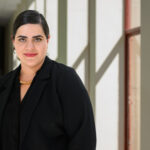Liftoff: The Climate Project at MIT takes flight
The leaders of The Climate Project at MIT met with community members at a campus forum on Monday, helping to kick off the Institute’s major new effort to accelerate and scale up climate change solutions. “The Climate Project is a whole-of-MIT mobilization,” MIT President Sally Kornbluth said in her opening remarks. “It’s designed to focus […]

The leaders of The Climate Project at MIT met with community members at a campus forum on Monday, helping to kick off the Institute’s major new effort to accelerate and scale up climate change solutions.
“The Climate Project is a whole-of-MIT mobilization,” MIT President Sally Kornbluth said in her opening remarks. “It’s designed to focus the Institute’s talent and resources so that we can achieve much more, faster, in terms of real-world impact, from mitigation to adaptation.”
The event, “Climate Project at MIT: Launching the Missions,” drew a capacity crowd to MIT’s Samberg Center.
While the Climate Project has a number of facets, a central component of the effort consists of its six “missions,” broad areas where MIT researchers will seek to identify gaps in the global climate response that MIT can help fill, and then launch and execute research and innovation projects aimed at those areas. Each mission is led by campus faculty, and Monday’s event represented the first public conversation between the mission directors and the larger campus community.
“Today’s event is an important milestone,” said Richard Lester, MIT’s interim vice president for climate and the Japan Steel Industry Professor of Nuclear Science and Engineering, who led the Climate Project’s formation. He praised Kornbluth’s sustained focus on climate change as a leading priority for MIT.
“The reason we’re all here is because of her leadership and vision for MIT,” Lester said. “We’re also here because the MIT community — our faculty, our staff, our students — has made it abundantly clear that it wants to do more, much more, to help solve this great problem.”
The mission directors themselves emphasized the need for deep community involvement in the project — and that the Climate Project is designed to facilitate researcher-driven enterprise across campus.
“There’s a tremendous amount of urgency,” said Elsa Olivetti PhD ’07, director of the Decarbonizing Energy and Industry mission, during an onstage discussion. “We all need to do everything we can, and roll up our sleeves and get it done.” Olivetti, the Jerry McAfee Professor in Engineering, has been a professor of materials science and engineering at the Institute since 2014.
“What’s exciting about this is the chance of MIT really meeting its potential,” said Jesse Kroll, co-director of the mission for Restoring the Atmosphere, Protecting the Land and Oceans. Kroll is the Peter de Florez Professor in MIT’s Department of Civil and Environmental Engineering, a professor of chemical engineering, and the director of the Ralph M. Parsons Laboratory.
MIT, Kroll noted, features “so much amazing work going on in all these different aspects of the problem. Science, engineering, social science … we put it all together and there is huge potential, a huge opportunity for us to make a difference.”
MIT has pledged an initial $75 million to the Climate Project, including $25 million from the MIT Sloan School of Management for a complementary effort, the MIT Climate Policy Center. However, the Institute is anticipating that it will also build new connections with outside partners, whose role in implementing and scaling Climate Project solutions will be critical.
Monday’s event included a keynote talk from Brian Deese, currently the MIT Innovation and Climate Impact Fellow and the former director of the White House National Economic Council in the Biden administration.
“The magnitude of the risks associated with climate change are extraordinary,” Deese said. However, he added, “these are solvable issues. In fact, the energy transition globally will be the greatest economic opportunity in human history. … It has the potential to actually lift people out of poverty, it has the potential to drive international cooperation, it has the potential to drive innovation and improve lives — if we get this right.”
Deese’s remarks centered on a call for the U.S. to develop a current-day climate equivalent of the Marshall Plan, the U.S. initiative to provide aid to Western Europe after World War II. He also suggested three characteristics of successful climate projects, noting that many would be interdisciplinary in nature and would “engage with policy early in the design process” to become feasible.
In addition to those features, Deese said, people need to “start and end with very high ambition” when working on climate solutions. He added: “The good thing about MIT and our community is that we, you, have done this before. We’ve got examples where MIT has taken something that seemed completely improbable and made it possible, and I believe that part of what is required of this collective effort is to keep that kind of audacious thinking at the top of our mind.”
The MIT mission directors all participated in an onstage discussion moderated by Somini Sengupta, the international climate reporter on the climate team of The New York Times. Sengupta asked the group about a wide range of topics, from their roles and motivations to the political constraints on global climate progress, and more.
Andrew Babbin, co-director of the mission for Restoring the Atmosphere, Protecting the Land and Oceans, defined part of the task of the MIT missions as “identifying where those gaps of knowledge are and filling them rapidly,” something he believes is “largely not doable in the conventional way,” based on small-scale research projects. Instead, suggested Babbin, who is the Cecil and Ida Green Career Development Professor in MIT’s Program in Atmospheres, Oceans, and Climate, the collective input of research and innovation communities could help zero in on undervalued approaches to climate action.
Some innovative concepts, the mission directors noted, can be tried out on the MIT campus, in an effort to demonstrate how a more sustainable infrastructure and systems can operate at scale.
“That is absolutely crucial,” said Christoph Reinhart, director of the Building and Adapting Healthy, Resilient Cities mission, expressing the need to have the campus reach net-zero emissions. Reinhart is the Alan and Terri Spoon Professor of Architecture and Climate and director of MIT’s Building Technology Program in the School of Architecture and Planning.
In response to queries from Sengupta, the mission directors affirmed that the Climate Project needs to develop solutions that can work in different societies around the world, while acknowledging that there are many political hurdles to worldwide climate action.
“Any kind of quality engaged projects that we’ve done with communities, it’s taken years to build trust. … How you scale that without compromising is the challenge I’m faced with,” said Miho Mazereeuw, director of the Empowering Frontline Communities mission, an associate professor of architecture and urbanism, and director of MIT’s Urban Risk Lab.
“I think we will impact different communities in different parts of the world in different ways,” said Benedetto Marelli, an associate professor in MIT’s Department of Civil and Environmental Engineering, adding that it would be important to “work with local communities [and] engage stakeholders, and at the same time, use local brains to solve the problem.” The mission he directs, Wild Cards, is centered on identifying unconventional solutions that are high risk and also high reward.
Any climate program “has to be politically feasible, it has to be in separate nations’ self-interest,” said Christopher Knittel, mission director for Inventing New Policy Approaches. In an ever-shifting political world, he added, that means people must “think about not just the policy but the resiliency of the policy.” Knittel is the George P. Shultz Professor and professor of applied economics at the MIT Sloan School of Management, director of the MIT Climate Policy Center, and associate dean for Climate and Sustainability.
In all, MIT has more than 300 faculty and senior researchers who, along with their students and staff, are already working on climate issues.
Kornbluth, for her part, referred to MIT’s first-year students while discussing the larger motivations for taking concerted action to address the challenges of climate change. It might be easy for younger people to despair over the world’s climate trajectory, she noted, but the best response to that includes seeking new avenues for climate progress.
“I understand their anxiety and concern,” Kornbluth said. “But I have no doubt at all that together, we can make a difference. I believe that we have a special obligation to the new students and their entire generation to do everything we can to create a positive change. The most powerful antidote to defeat and despair is collection action.”
Related
-
 September 5, 2023 | Benjamin DanielMIT and Czech Teams develop Novel Digital History Project supported by MISTI Czech Seed Fund
September 5, 2023 | Benjamin DanielMIT and Czech Teams develop Novel Digital History Project supported by MISTI Czech Seed Fund -
 September 10, 2024 | School of Humanities Arts and Social SciencesMeet the 2024 tenured professors in the MIT School of Humanities, Arts, and Social Sciences
September 10, 2024 | School of Humanities Arts and Social SciencesMeet the 2024 tenured professors in the MIT School of Humanities, Arts, and Social Sciences -
 September 15, 2024 | Austin Chen MIT News correspondentProtecting the rights of internet users, in Mexico and worldwide
September 15, 2024 | Austin Chen MIT News correspondentProtecting the rights of internet users, in Mexico and worldwide
Share a Story
Do you have a story to share about an event, a publication, or someone in the community who deserves a spotlight? Reach out to the SHASS Communications Team with your idea.
Email SHASS Communications